 Moreover, the seabed might even be unusable for anchoring, as is the case with
cables, telephone lines or pipelines, which will be indicated on the nautical
chart as illustrated on the right.
Moreover, the seabed might even be unusable for anchoring, as is the case with
cables, telephone lines or pipelines, which will be indicated on the nautical
chart as illustrated on the right.
Anchoring
This is a free course on anchoring techniques featuring anchors, seabeds, trip lines and of course the Mediterranean mooring manoeuvre. t to have expert anchoring skills. It is vitally importan:
Anchoring is about safety. Under the very worst conditions - when leaving the anchorage or port is dangerous - you should be able to rely on your anchor system.
Since a good anchor digs itself into the seabed we're interested in more than just the upper layer. Shells, weed and sea grasses might prevent an anchor from grabbing. But once through, the anchor can dig itself into the lower sandy, mud, peat, cobbles, stony or clay bottom, each with different holding characteristics, requiring different anchor types.
Mud, for instance will provide better
holding than peat - which is often too watery - yet usually we cannot pick the
seabed.
 Moreover, the seabed might even be unusable for anchoring, as is the case with
cables, telephone lines or pipelines, which will be indicated on the nautical
chart as illustrated on the right.
Moreover, the seabed might even be unusable for anchoring, as is the case with
cables, telephone lines or pipelines, which will be indicated on the nautical
chart as illustrated on the right.
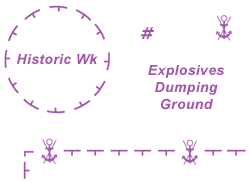 Other reasons why anchoring may be forbidden are an explosives dump area or a
historic wreck, or simply because anchoring will block the passage. Also the
seabed might be foul, which is indicated on nautical charts by a
#,
marking perhaps old chains or simply polluted ground below.
Other reasons why anchoring may be forbidden are an explosives dump area or a
historic wreck, or simply because anchoring will block the passage. Also the
seabed might be foul, which is indicated on nautical charts by a
#,
marking perhaps old chains or simply polluted ground below.
Likewise you should avoid naval (submarine) exercise areas, nature reserves,
precious coral and areas with divers down (see the
“A”
flag and
“diver down”
flag).
|
S |
Sand |
|
|
M |
Mud |
|
|
Cy, Cl |
Clay |
|
|
G |
Gravel |
|
|
Co |
Coral |
|
|
Cb |
Cobbles |
|
|
Sn |
Shingle |
|
|
P |
Pebbles |
|
|
St |
Stones |
|
|
Rk, Rky |
Rock, Rocky |
|
|
Ch |
Chalk |
|
|
Sh |
Shells |
|
|
Wd |
Weed |
|
|
S/M |
Two layers (example: sand over mud) |
|
|
|
Kelp |
|
|
|
Spring in seabed |
Note that lowercase letters are used for these qualifying terms.
|
s |
small |
|
f |
fine |
|
m |
medium |
|
c |
coarse |
|
h |
hard |
|
sm |
small |
|
bk |
broken |
|
v |
volcanic |
Thick mud, clay and sand will provide good holding, as will pebbles once the
anchor is deep enough. A rocky seabed might perhaps provide even better holding,
but also increases the risk of a permanent mooring when the chain or anchor
itself gets jammed under a heavy boulder. Therefore, especially when dealing
with rocks, the use of a trip line or
tripping line is recommended to enable you to
retrieve your anchor. Thick layers of shells are rather useless: at least with
seaweed and grass the anchor has a chance to penetrate into the more suitable
layers underneath.
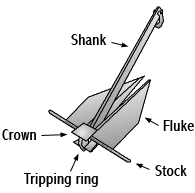
The shank is the stem of the anchor in which direction is pulled to set (bury) the anchor.
The crown connects the various parts of the modern anchor.
The stock turns the anchor into an attitude that enables the flukes to dig into the sea bed.
The tripping ring is used for the optional tripping line: by pulling the tripping line, the anchor will break out.
The flukes will be buried into the seabed. The very tip of a fluke is sometimes called the bill.
Criteria for anchor selection
reliability to set
holding power
ability to withstand veering (i.e. resetting qualities
\susceptibility to damage
Bruce anchor
 Despite
failing most authoritative anchor tests, the Bruce anchor is still quite
popular, mainly because it is so easy to set. It won't penetrate deep so this
anchor is not recommended for anchoring at night of above 6 Bft. The Bruce - and
other similar “claw” anchors - are ideal though for a short lunch stop.
Despite
failing most authoritative anchor tests, the Bruce anchor is still quite
popular, mainly because it is so easy to set. It won't penetrate deep so this
anchor is not recommended for anchoring at night of above 6 Bft. The Bruce - and
other similar “claw” anchors - are ideal though for a short lunch stop.
CQR anchor
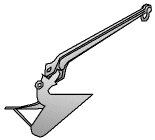 Definitely one of the best anchors around the stockless CQR does wonders in mud
or sand. This “plow” anchor was patented in 1933 by Sir Geoffrey Taylor.
Definitely one of the best anchors around the stockless CQR does wonders in mud
or sand. This “plow” anchor was patented in 1933 by Sir Geoffrey Taylor.
The CQR generally penetrates better into weeds and grasses than the Danforth
type anchors, it resets easily and the hinge allows about 75° of sideways motion
(each side).
Delta anchor
 The
Delta anchor is a variation on the CQR by the same manufacturer: the principal
difference is the fixed shank without the hinge, which shape is also altered to
allow the anchor to deploy automatically from the bow roller. The flukes are
improved as well.
The
Delta anchor is a variation on the CQR by the same manufacturer: the principal
difference is the fixed shank without the hinge, which shape is also altered to
allow the anchor to deploy automatically from the bow roller. The flukes are
improved as well.
Danforth anchor
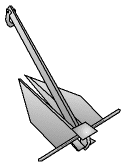 This anchor type is the storm-anchor par excellence
This anchor type is the storm-anchor par excellence![]() .
It has a low weight and incredible holding power according to nearly all safety
tests. Preferred anchor in easy penetrable seabeds except very fine sand, though
there are ill-performing forgeries around that only look like a Danforth. Among
all the Danforth-like anchors the “Performance anchor” and the “Fortress
anchor” is by far the best version a
yachtsman can buy
.
It has a low weight and incredible holding power according to nearly all safety
tests. Preferred anchor in easy penetrable seabeds except very fine sand, though
there are ill-performing forgeries around that only look like a Danforth. Among
all the Danforth-like anchors the “Performance anchor” and the “Fortress
anchor” is by far the best version a
yachtsman can buy![]() .
Some Danforths let you change the angle between flukes and shank.
.
Some Danforths let you change the angle between flukes and shank.
Besides these four there are of course
other interesting anchors, notably the recent Spade
anchor - an acronym for the French Societé de
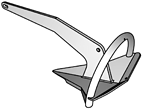 Production d'Accastillage et Divers Equipements, which is an auspicious design
Production d'Accastillage et Divers Equipements, which is an auspicious design![]() .
.
Other promising anchors are the Max anchor (soft
mud), the triple fluked Bulwagga (dense weeds
penetration), and the German designed Bügel.
The Rocna, the Bügel-like anchor shown here on the
right, is a very recent product with mixed results - a fiercely hyped marketing
campaign claims otherwise…
Hook-like “rock anchors” can be used to
connect your yacht directly to the rocks above the water.
Helical “screw anchors” or “beach anchors” are specially designed to be manually
screwed down in the sandy seabed of shallow waters or on a nearby beach, as is
often done in Greece and Turkey.
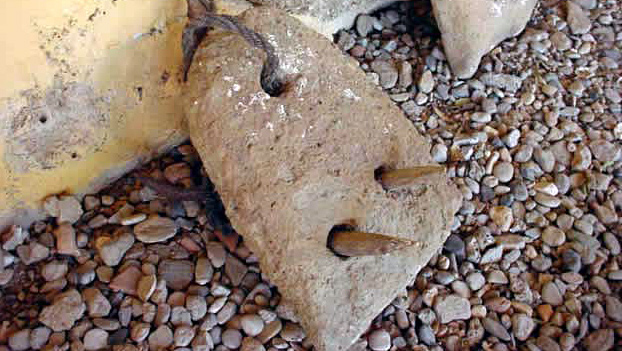 Not a “rock anchor” but rather an
Not a “rock anchor” but rather an
old fashioned anchor -
Monemvasia, Argolic Gulf.
tripline anchor buoy [instruction image] tripline = retrieval line
chain should be heavy, or in case of rope een "voorloop" is handig of een gewicht op een karretje. long enough, the longer the better, scoop tov diepte. [instruction image] the electrical winch. how to use : engine running, fuse switch and help to motor in the right direction though do not use the engine when lagerwal or close to quay -> might foul your prop. use the rod to lower the anchor in one time, not always a good idea because the chain might foul the anchor. slampamper
If using bow anchor point your yacht upstream or upwind (which ever is the strongest) swing circle
Other boats at anchor. If possible, anchor away from other boats. If the anchorage is too crowded to permit that, well, you're beyond the scope of this course, but try to anchor near boats that are similar to yours. For example, a keelboat is much more influenced by currents than say a powerboat with its shallow draft. Powerboats instead tend to swing with the wind. Of course, in the absence of current, the keelboat will also swing with the wind. Assess how boats will swing on their anchors if conditions change. Your boat will swing in a circle whose radius is, to a first approximation, the length of the rode you have out plus the length of your boat. The swing circle for other boats is found in the same manner. You'd like to be further away than your swing radius from the swing circle of any other boat.
use maximum anchor line. Achtergrondspeiling
Any wash of ferries, changes of wind direction, any swell entering the bay, gusts, etc. will be cushioned by the catenary curve of the anchor chain which will keep the yacht clear of the quay: berthing along side won't protect the yacht.
In the Mediterranean - especially in Greece - berthing along side is often hampered by blocks of ballasting near the quay.
No neighbouring crews walking on your deck greatly adds to your privacy, especially so if bows-to.
Some islands in the Mediterranean are
home to rats, cockroaches, etc. Mediterranean mooring (with the gangway
raised from the quay!![]() )
helps to prevent vermin getting on board.
)
helps to prevent vermin getting on board.
It is much easier to leave a (crowded) port. No skipper likes to be the innermost yacht - four yachts thick - in an along side mooring situation.
As the bow anchor typically offers more holding power and a longer (heavier) anchor chain it is very useful to become an expert in the stern-to variant of berthing Mediterranean-style.
Position the bow the full length of your anchor chain away, or otherwise as far as possible, ready to drop anchor. In a crosswind go a little upwind since by the time the anchor touches seabed you will have drifted out of position.
Drop anchor in front of the spot on the quay you are aiming for. Note, that anchoring NOT perpendicular to the quay (as people often do in a crosswind), could well mean crossing and potentially fouling the anchor lines of your neighbours. Also, the wind could be blowing from the opposite direction later.
Just before the anchor reaches the seabed, put the engine in reverse. Maintaining speed helps you to manoeuvre, and moving astern also prevents fouling the anchor with its own chain. Moreover, if there is room, I would advice a gentle one knot speed in reverse, before dropping the anchor:
Less chance the anchor will foul.
Less drifting out of position in case of crosswind.
The anchor will often set earlier which means a greater distance from quay, maximising the scope.
With the engine in reverse, the “prop walk” will steer the yacht to the left when looking at the intended spot on the quay. Yet, this is only the case when the engine is in reverse and not if it is in neutral. First make speed and counteract the prop walk as much as possible by putting the rudder at 45 degrees (more will only brake), then put the engine in neutral and the yacht will listen to the rudder normally.
The crew on the foredeck should put a mild tension on the anchor line, while reversing, to help the anchor dig deeper. Not too much, since you would lose speed and also the anchor could break out.
Near the quay there is an increased risk on lose lines, fishing nets and other rubble, so it is good practise not to use the prop the last few metres. Braking by feeding the anchor less line works better also helps the anchor set firmly.
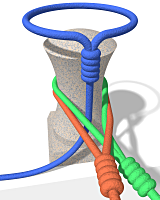
Etiquette !
Orange came first, then green and you are blue! With one line on
shore (windward one if cross wind), it is time to put pressure on the
anchor: take anchor chain in till the catenary curve becomes more of a
straight line. If after a while (sometimes immediately) the catenary curve
reappears, your anchor has not set... by the time you have winched one third
of the anchor line back on board, start considering a second attempt.
So, during this whole Mediterranean mooring manoeuvre, not so much the helmsman but the foredeck is in control. Although it is a first a bit scary to steer backwards into a tight slot between two expensive yachts, speed keeps the yacht manoeuvrable.
Tip: Plan to arrive early (typically
before 15:00) at the port of destination so that there is ample space to
manoeuvre and lots of berths at the quay to choose from.
Your flukes
caught another anchor chain
[instruction image]
Usually you can lift the other anchor chain up with your anchor, so even in
murky water the problem is then clear. Hoisting up the other chain (could
also be from a larger vessel or a much heavier dedundant chain from sunken
buoy) does put a lot of stress on the yacht. Moreover, it could break out
the other anchor!
Make a line round the other chain, ease your anchor a few metres and turn
the flukes away from the chain. Next get your anchor on deck and drop the
other chain.
A very handy gadget is a hook you can release under pressure. Also means
that you don't have to hoist the other chain to sealevel in clear water.
Your anchor
jammed under rock or cable
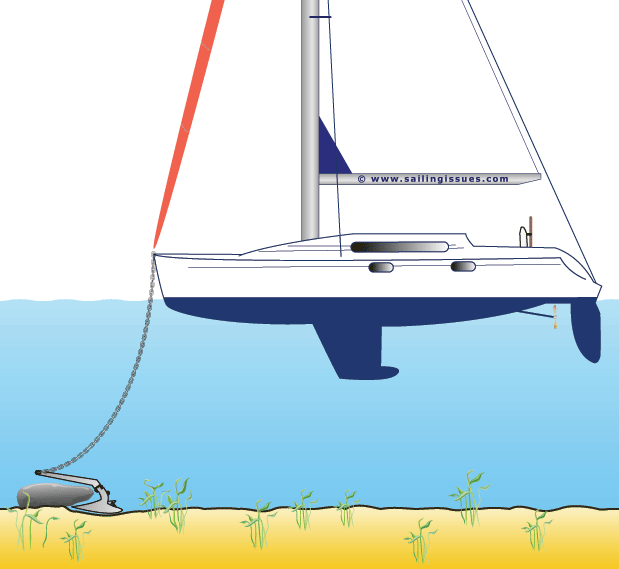
anchor chain tout
send down the messenger line
slack anchor chain
pull tripline/messenger line in opposite direction to where the shank is facing
Anchor aweigh
The moment the chain starts taking the weight of the anchor, which is raised
from the seabed when hauling up the anchor.
Anchor chain
or anchor rode
A line (chain, nylon or steel cable) used to hold a vessel fast to the anchor.
Anchor watch
Crewmen assigned to keep watch over the ship while at anchor and monitor the
position of the ship to detect movement of the anchor, keep an eye on the
weather and other yachts anchored in the vicinity.
Anchor winch
or windlass
Substantial mechanical advantage for taking a strain on lines. A few turns of
the line are taken on the drum to achieve a purchase, then the winch is turned
to bring the line taut. The bitter end of the line can then be secured to a
cleat or bollard.
Bitter end
The very last piece of the anchor line that is available at windlass. Thus, is a
ship is riding out a gale in a treacherous stretch of water with no more line
left to pay out, the ship and crew are indeed in trouble when at the bitter end.
Scope The
ratio between the length of anchor chain and depth. At least a 8:1 ratio is
recommended, so when the anchor is dropped at a depth of 10 metres![]() it is advised to use 80 metres of chain. With a kellet
you can reduce the scope without reduction of safety.
it is advised to use 80 metres of chain. With a kellet
you can reduce the scope without reduction of safety.
Setting, resetting
Trip line or
tripping line
A light line secured to the tip of the anchor and marked with a float, employed
to release the flukes when they are fouled on the bottom.
Veering
1) Changing direction of the wind clockwise, opposite of backing wind.
2) To lead a line around a bitt or block, thereby changing its direction for a
purchase.
3) To indicate that the relative wind is changing direction toward the stern, as
in “Ease the sheets; the wind is starting to veer.”
4) To let out rope. “You can veer out about 20 feet of the dinghy painter so it
will tow better.”
To haul up short
To take in the anchor chain so that there is a short scope but the anchor
remains secure on the bottom in preparation for departure.